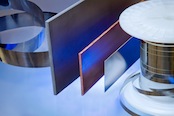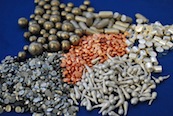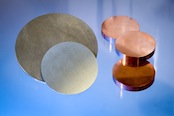Silver
Pure silver has a brilliant white metallic luster. It is a little harder than gold and is very ductile and malleable. Pure silver has the highest electrical and thermal conductivity of all metals, and possesses the lowest contact resistance.
Silver is used in a very broad range of applications, including, but not limited to, jewelry, coinage, electrical and electronic devices, and photographic compounds. In some of these applications, silver is alloyed to improve its hardness. The primary alloying element is copper, which, in proportions of 7.5% and 10%, forms the recognized standards for sterling and coin silver, respectively.
The intrinsic qualities of silver (that is, excellent electrical and thermal conductivity, high reflectivity, good corrosion resistance, and ductility) make it a good material choice for a wide range of industrial applications. These applications include contact rivets, capacitor components, fuse links, thin-film coatings for optically and thermally efficient glass, conductive inks, plating anodes, and photographic emulsions.
Structure:
Crystal Structure: Face-centered cubic at 25 oC, a = 0.408621 nm
Mass Characteristics:
Atomic Weight: 107.868
Density: 10.49 g/cm3 at 20 oC
Volume Change on Freezing: 5% contraction
Thermal Properties:
Melting Point: 961.9 oC
Boiling Point: 2163 oC
Coefficient of Linear Thermal Expansion:
20 oC - 19.0 µm/m * K
-190 oC to 0 oC - 17.0 µm/m * K
0 oC to 900 oC - Lt = Lo (1 + 19.494 x 10-6 t + 1.0379 x 10-6 t2 + 2.375 x 10-12 t3, where t is inoC
0 oC to 100oC, 19.68 µm/m * K
0 oC to 500 oC, 20.61 µm/m * K
Specific Heat:
Solid: 25 oC, 0.235 kJ/kg * K
127 oC, 0.239 kJ/kg * K
527 oC, 0.262 * K
961 oC, 0.297 kJ/kg * K
Liquid: 961 to 2227 oC, 0.310 kJ/kg * K
Latent Heat of Fusion: 104.2 kJ/kg
Latent Heat of Vaporization: 2.63 MJ/kg
Recrystallization Temperature: 20 to 200 oC, depending on purity and amount of cold work
Thermal Conductivity: 428 W/m * K at 20 oC
356 W/m * K at 450 oC
Electrical Properties:
Electrical Conductivity: 108.4% IACS for extremely pure silver
Electrical Resistivity: 14.7 nΩ * m at 0 oC
Temperature Coefficient: from 0 to 100 oC, 0.0041 per K
Cold working of silver considerably increases resistivity: 5% for 90% reduction. Annealing commercially pure silver successively in air and hydrogen disrupts grain boundaries and increases resistance. Tension reduces resistivity slightly as does hydrostatic pressure: 12,000 kg/cm2 causes 4% reduction.
Thermal Electromotive Force: vs platinum, +0.74 mV; cold junction at 0 oC, hot junction at 100 oC
Magnetic Properties:
Magnetic Susceptibility: Volume: -2.27 x 10-6 mks
Optical Properties:
Color: As a result of the high and fairly uniform reflectance in the visible range, silver is considered white, but if human eyes were sensitive to a slightly shorter wavelength region, silver would appear to have color.
Reflectance: For clean silver, high in the visible an infrared but low in near-ultraviolet.
Emittance: Solid silver at 0.65 µm: extremely low and not known accurately; values of 0.044 µm at 940 oC and 0.072 µm at 980 oC have been observed for liquid silver. Other experiments showed no discontinuity at the melting point of silver, the emissivity being about 0.055 at about 700 oC.
Mechanical Properties:
Tensile Properties: Considerable spread in values for tensile strength and hardness of high-purity silver. Average tensile strength, 125 MPa for 5 mm wire annealed at 600 oC.
Hardness: High-purity silver; hydrogen anneal 650 oC, 25 HV; air anneal at 650 oC, 27 HV; electro-deposited silver (higher electrical resistivity than wrought silver), 100 HV
Elastic Modulus: Strained 5%, then heated 0.5 hour at 350 oC, 71.0 GPa
Poisson’s Ratio: Annealed: 0.37; hard drawn, 0.39
Liquid Surface Tension: 0.923 N/m at 995 oC

 ALLOYS
ALLOYS 





